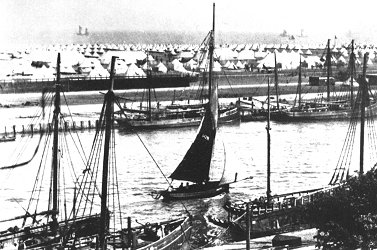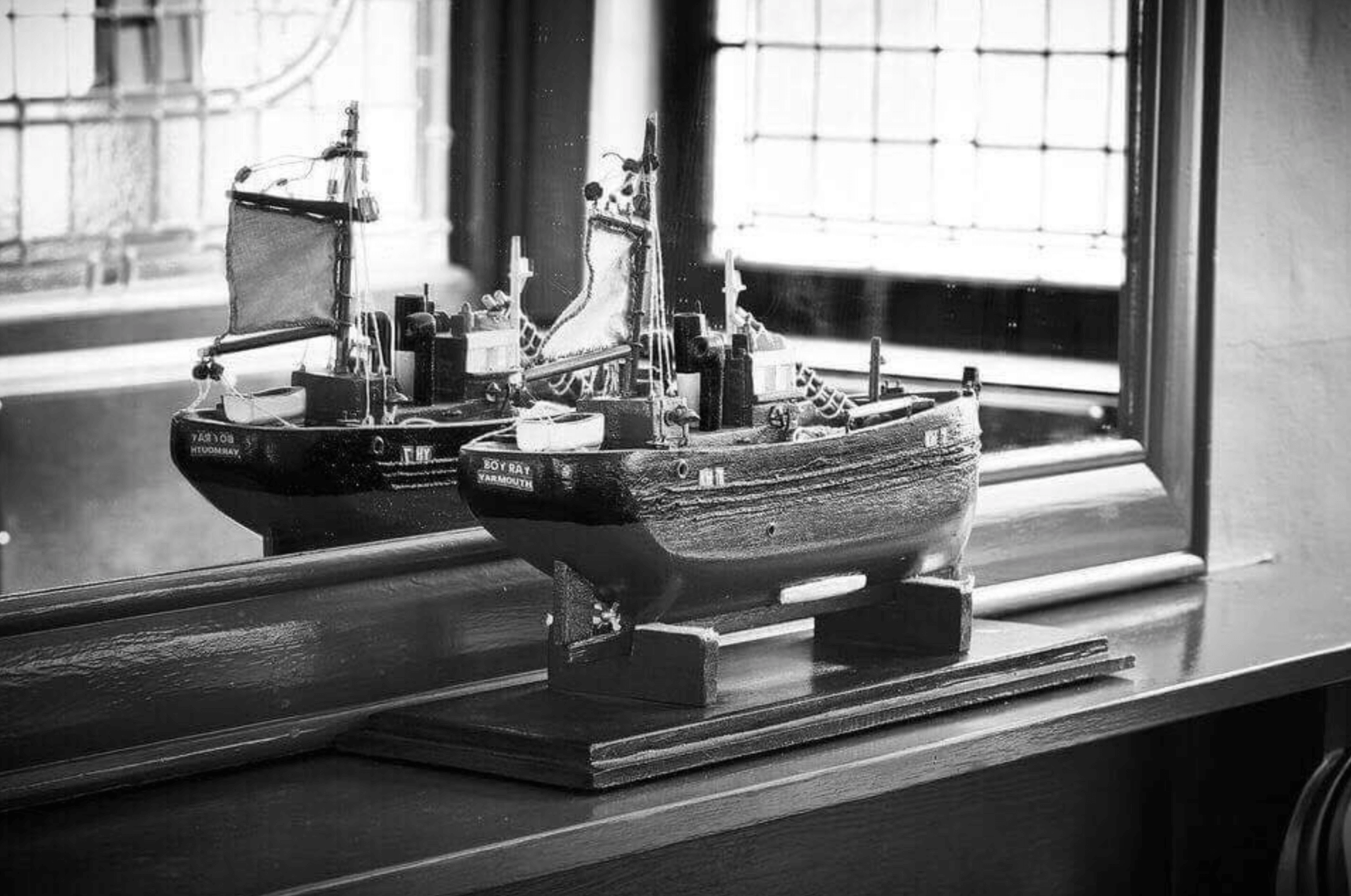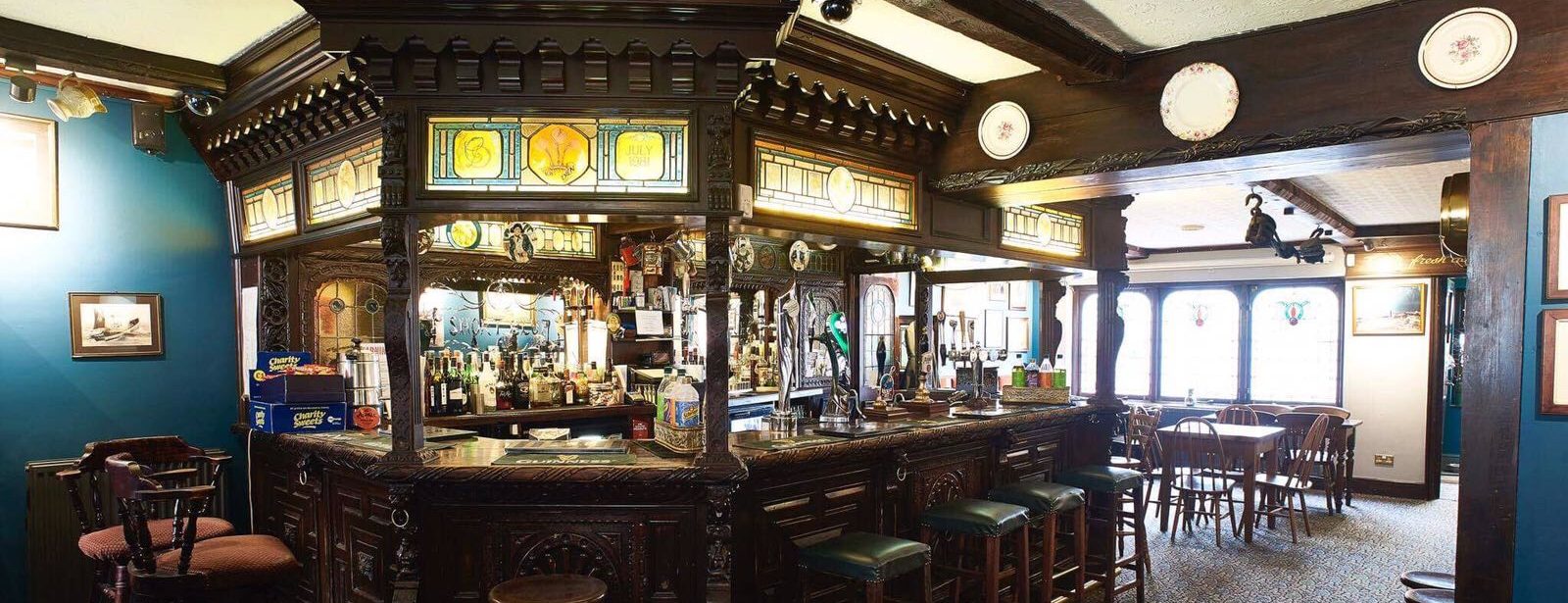In 1795 a young Scrymgeour Hewett left his native Fifeshire to look after some property in Dagenham for an aunt, where he met, courted and married Sarah Whennel – the daughter of a Barking fishing boat owner. This was to be his introduction to fishing, eventually taking over his father-in-law’s two boats which was to be the small beginning of the “Short Blue” fleet, so named because of its house flag identifying all the fleet’s fishing boats.
 In 1815, his son Samuel took over the running of the increased fleet, and he made it his intention to explore the North Sea fishing grounds. What made the Short Blue fleet expand and prosper was the intuition to keep ice onboard, allowing the trawling smacks to go further afield to the new fishing grounds he had found on his voyages, and allowing them to keep the fish a lot fresher. At first the ice was bought from Norway at high cost but he soon realised there was a large potential supply around Barking. If the marshes were flooded in the winter he could pay farmers to deliver their “crop” to large ice houses with 26 inch thick walls for use during the summer. This process revolutionised the fishing industry.
In 1815, his son Samuel took over the running of the increased fleet, and he made it his intention to explore the North Sea fishing grounds. What made the Short Blue fleet expand and prosper was the intuition to keep ice onboard, allowing the trawling smacks to go further afield to the new fishing grounds he had found on his voyages, and allowing them to keep the fish a lot fresher. At first the ice was bought from Norway at high cost but he soon realised there was a large potential supply around Barking. If the marshes were flooded in the winter he could pay farmers to deliver their “crop” to large ice houses with 26 inch thick walls for use during the summer. This process revolutionised the fishing industry.
When the first icehouse was built in Gorleston in 1846, Hewett began to see the advantages of basing his trawling smacks in the Yarmouth area with new rich fishing grounds off the coast of Yorkshire and Lincolnshire. Hewett bought an area of Gorleston’s riverside, about a quarter of a mile in length, between the area of Darby’s Hard and Baker Street. A new quay was built with a dock and blocks of buildings employing engineers, blacksmiths, block and mast makers, net makers, sailmakers, boat builders and twine spinners. An icehouse still stands on the quay at the bottom of Ice House Hill (at the rear entrance of our public house), serving as a reminder of this area’s great industry, when Gorleston was home to the world’s largest trawling fleet.
 The move of the “Short Blue” fleet to its new base at Gorleston began in around 1860 and was largely organised by Samuel’s son, Robert, who became Managing Director when Hewetts became a limited company in 1864. Originally he lived in Gorleston High Street in a large house known as the Woodlands which stood where the shopping precinct is now, but moved back to Barking around 1870 when the company was restructured, having sold over 200 trawling smacks and retaining just the carriers which transported the fish from the dock to the markets. The fleet was reorganised in 1879 and his brother-in-law Harvey Harvey-George moved to Gorleston to take over the day to day management of the fleet, living first at Surbiton Lodge which used to be on the south corner or Trafalgar Road East and the High Street.
The move of the “Short Blue” fleet to its new base at Gorleston began in around 1860 and was largely organised by Samuel’s son, Robert, who became Managing Director when Hewetts became a limited company in 1864. Originally he lived in Gorleston High Street in a large house known as the Woodlands which stood where the shopping precinct is now, but moved back to Barking around 1870 when the company was restructured, having sold over 200 trawling smacks and retaining just the carriers which transported the fish from the dock to the markets. The fleet was reorganised in 1879 and his brother-in-law Harvey Harvey-George moved to Gorleston to take over the day to day management of the fleet, living first at Surbiton Lodge which used to be on the south corner or Trafalgar Road East and the High Street.
The men on the smacks were paid a weekly wage with a share of the profit earned on the trip. It was a tough and dangerous life with six to eight crew on a 75 foot smack, living, sleeping and eating in cramped conditions with no provision for cleanliness. During storms they would be confined to the cabin or risk getting washed overboard. During times of little or no wind when the smacks weren’t able to fish, many of the crews were lured on to “Copers”, which were Dutch or Belgian ships that hung around the fleet to sell cheap duty free tobacco and spirits, which often led to the men getting hopelessly drunk and sometimes even exchanging their smacks equipment for drink.
 Harvey Harvey-George was aware of these issues and in 1881 employed Ebeneezer Mather, a young social worker who visited the Short Blue fleet on the Dogger Bank. He was appalled at the conditions the men had to endure in how they lived and worked. Conditions where accidents were frequent but without medical aid. The men were exploited by the Copers and were a liability when drunk not only to their sober crew mates but also the fleet and the owners.
Harvey Harvey-George was aware of these issues and in 1881 employed Ebeneezer Mather, a young social worker who visited the Short Blue fleet on the Dogger Bank. He was appalled at the conditions the men had to endure in how they lived and worked. Conditions where accidents were frequent but without medical aid. The men were exploited by the Copers and were a liability when drunk not only to their sober crew mates but also the fleet and the owners.
In 1882 Ebeneezer Mather bought a smack from the Hewett fleet and set sail from Gorleston for the fishing grounds with medical supplies, warm clothes, tobacco, bibles and religious tracts. To help he bought duty free tobacco from the continent where the Copers obtained their supplies and sold it to the fishermen at £1 per pound, a third cheaper than the Copers. Slowly the ships visits to the fleets became more and more welcome and the number of mission ships grew with hospital ships also added. The Copers were forced out and their operation made illegal by an international convention in 1886. The Royal National Mission to Deep Sea Fishermen remains active in the welfare of fishermen today.
 In 1882, Hewett employed 570 fishermen and over 100 more on the ground comprising of blacksmith’s, engineers, sailmakers, etc. However, as the end of 19th centruy neared, so did the future of the fleet as well as Gorleston and Yarmouth as the great fishing centre it once was. The introduction of the steam trawler which was outdating the smacks with their greater range and speed, and along with the emergence of ports such as Grimsby and Hull which were closer to the developing northern markets resulted in the end of the fleet. In 1901 the Short Blue fleet was laid up along Gorleston Quay and an era had come to an end. Some boats were broken up, some were sold to continetal owners, some were converted for coastal trading. The majority of Hewett’s men moved to the northern ports to continue fishing, this time however on the all-conquering steam trawlers.
In 1882, Hewett employed 570 fishermen and over 100 more on the ground comprising of blacksmith’s, engineers, sailmakers, etc. However, as the end of 19th centruy neared, so did the future of the fleet as well as Gorleston and Yarmouth as the great fishing centre it once was. The introduction of the steam trawler which was outdating the smacks with their greater range and speed, and along with the emergence of ports such as Grimsby and Hull which were closer to the developing northern markets resulted in the end of the fleet. In 1901 the Short Blue fleet was laid up along Gorleston Quay and an era had come to an end. Some boats were broken up, some were sold to continetal owners, some were converted for coastal trading. The majority of Hewett’s men moved to the northern ports to continue fishing, this time however on the all-conquering steam trawlers.
